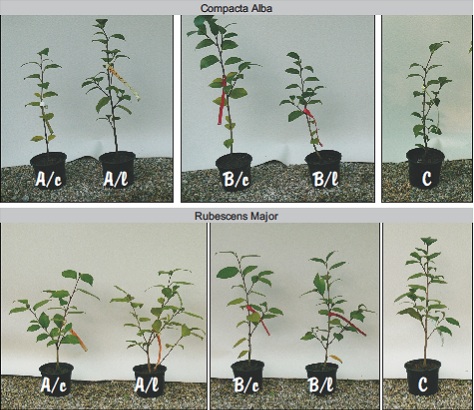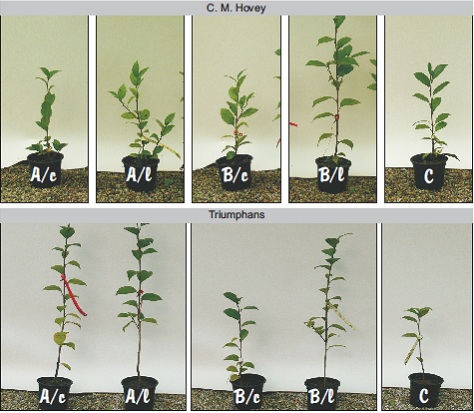Effects of liming on the growth of Camellia japonica cultivars in acid soils
Salinero M.C.a1, Vela P. a, Sainz M.J. b, Couselo J.L. a
aEstación Fitopatolóxica do Areeiro, Deputación de Pontevedra, Subida a la Robleda s/n, 36153 Pontevedra, España
bDepartamento de Producción Vegetal, Universidad de Santiago de Compostela, Campus Universitario s/n, 27002 Lugo, España
1 Author for correspondence: carmen.salinero@depo.es
Introduction
Despite the fact that there is scarce information about soil pH requirements of Camellia species and cultivars, these plants are known to grow best in acid soils. Soils that have a pH range between 4.5 and 5.5 is considered optimal for camellias, since at higher pH these plants are supposed to suffer from Fe and Mn deficiencies (Uchida and Hue, 2000). However, there have been no studies on pH differences, or on other soil properties, or requirements among species of camellias or among cultivars of a given species, except for Camellia sinensis, the tea plant, due to its economic importance. The optimum pH range for C. sinensis is 5-5.6 (Othieno, 1992). Yield and quality of tea are negatively affected in highly acidic soils, since availability of nutrients is low (Ruan et al., 2004).
Camellia japonica is cultivated worldwide as an ornamental. More than 32,000 cultivars of this species are included in the International Camellia Register (Savige, 1994), although major camellia-producing nurseries grow a relatively low number of cultivars. No information is available on optimum substrate pH for any of these cultivars. Camellia plant production nurseries use substrates based on mixtures of composted pine bark and peat that have an acidic pH. When sold for gardening and landscaping, camellia plants are frequently transplanted to soils that can have a pH higher than 5.5 due either to natural soil characteristics or to soil liming. Lime application is a common agronomic practice in acid soils to improve macronutrient availability (especially phosphorus) and reduce aluminium toxicity for plants. In this work we studied the growth response of four Camellia japonica cultivars in three acid soils affected by liming.
Materials and methods
Bulk soil was collected at three sites, namely Areeiro-Lalín (A), Areeiro base (B), and Lalín nº 1 (C) in NW Spain. Soils were air-dried and passed through a 5 mm mesh to remove coarse rock fragments and plant material. For analysis of main physico-chemical soil characteristics (Table 1), samples of each soil were passed through a sieve with 2 mm mesh.
Table 1. Characteristics of soils
|
Soil |
pH |
C |
OM |
N |
C/N |
P |
Ca |
Mg |
K |
Al |
Al sat. |
|
|
H2O |
% |
|
mg kg-1 |
cmol kg-1 |
% |
|||||
|
A |
5.04 |
5.89 |
10.15 |
0.39 |
15.06 |
49.42 |
0.87 |
0.07 |
0.11 |
2.65 |
64.25 |
|
B |
5.48 |
2.46 |
4.24 |
0.18 |
13.67 |
34.65 |
1.50 |
0.33 |
0.46 |
1.00 |
28.21 |
|
C |
5.91 |
3.08 |
5.31 |
0.30 |
10.10 |
5.60 |
1.38 |
0.72 |
0.15 |
0.60 |
19.19 |
Half volume of soils A and B was limed to lower percentage of Al saturation under 20%. Soil C was not limed due to its low Al saturation. Well-rooted one-year old plants of Camellia japonica ‘Compacta Alba’, ‘Rubescens Major’, ‘Triumphans’ and ‘C.M. Hovey’ were transplanted to 0.8 L pots filled with sand and the corresponding soil, either limed or not, in a ratio of 1:3 (in vol.). Pots were randomly arranged under shade mesh exposed to natural environmental conditions. Plants were fertilized with a slow-release NPK fertilizer, and regularly watered.
Plant height, stem diameter at 5 cm above pot surface, number of shoots, total length of shoots (sum of lengths of individual shoots), and number of leaves were recorded after one year of growth. Data were subjected to analysis of variance (ANOVA), using the least significance difference test for means separation at P<0.05.
Results and discussion
The four cultivars of C. japonica showed different growth responses in the unlimed soils and when cultivated soils were limed (Table 2). ‘C.M. Hovey’ and ‘Rubescens Major’ plants showed a poor similar growth in all soils, either limed or unlimed, suggesting that soil characteristics other than, or in addition to, pH were not suitable for them. However ‘Compacta Alba’ and especially ‘Triumphans’ plants grew well and were best at the lowest pH (soil A unlimed), reaching more than 20 cm in height. The cultivar ‘Compacta Alba’ was very sensitive to increased soil pH, as plants growing in the soil A limed, soil B limed or unlimed, and soil C showed a significantly lower height than in the soil A unlimed. ‘Triumphans’ plants presented a similar growth in the soil A limed or unlimed, but lower in the other two soils (at pH 5.5 or over).
These results indicate that cultivars of C. japonica might have different growth responses when grown in different soils: this should be studied when the commercial purpose of nursery-produced plants is to sell the plant for planting in soils.
Table 2. Plant height, number of new leaves, length of new shoots and internode length of four cultivars
of Camellia japonica after one year growth in three soils, limed or unlimed.
|
|
|
Soil A |
Soil B |
Soil C |
|
||||||||
|
|
|
Control |
Limed |
Control |
Limed |
|
|
||||||
|
Cultivar |
|
pH 5.0 |
|
pH 5.5 |
|
pH 6.0 |
|
||||||
|
‘C.M. Hovey’ |
Plant height (cm) |
7.3 |
6.9 |
6.7 |
9.0 |
8.5 |
|||||||
|
|
Nº new leaves |
1.8 |
3.5 |
3.4 |
2.4 |
2.3 |
|||||||
|
|
Length of new shoots (cm) |
2.1 |
4.1 |
4.1 |
3.2 |
2.9 |
|||||||
|
|
Internode length (cm) |
1.48 |
1.12 |
1.20 |
1.38 |
1.33 |
|||||||
|
‘Compacta Alba’ |
Plant height (cm) |
21.5 a |
15.6 b |
14.3 b |
16.8 b |
16.8 b |
|||||||
|
|
Nº new leaves |
3.4 |
4.0 |
3.8 |
3.4 |
5.2 |
|||||||
|
|
Length of new shoots |
8.2 |
9.0 |
7.6 |
6.6 |
10.4 |
|||||||
|
|
Internode length (cm) |
2.35 |
2.28 |
1.96 |
2.05 |
2.09 |
|||||||
|
‘Rubescens Major’ |
Plant height (cm) |
13.8 |
14.3 |
14.7 |
12.9 |
14.5 |
|||||||
|
|
Nº new leaves |
3.8 |
4.0 |
4.3 |
3.8 |
4.6 |
|||||||
|
|
Length of new shoots |
9.9 |
9.5 |
11.8 |
10.5 |
11.9 |
|||||||
|
|
Internode length (cm) |
2.68 |
2.38 |
2.90 |
2.59 |
2.54 |
|||||||
|
‘’Triumphans’ |
Plant height (cm) |
23.1 a |
23.4 a |
10.2 b |
14.8 b |
13.8 b |
|||||||
|
|
Nº new leaves |
5.4 |
4.8 |
3.6 |
4.2 |
4.8 |
|||||||
|
|
Length of new shoots |
13.3 a |
13.5 a |
7.1 b |
9.9 b |
8.6 b |
|||||||
|
|
Internode length (cm) |
2.45 ab |
2.78 b |
1.92 a |
2.35 ab |
1.73 a |
|||||||


Figure 1. Plants of Camellia japonica cultivars ‘Compacta Alba’, ‘Rubescens Major’, ‘C.M. Hovey’ and ‘Triumphans’ after one year of growth in three soils (A, B and C) unlimed (C) or limed (L).
ACKNOWLEDGEMENTS
This work was funded by Xunta de Galicia, Spain (grant PGIDIT06 RAG26103PR).
Literature Cited
Othieno C.O. 1992. Soils. En: Tea, cultivation to consumption. Eds. K.C. Willson, M.N. Clifford. Chapman and Hall, London, pp. 137-172.
Ruan J., Ma L., Shi Y., Zhang F. 2004. Effects of litter incorporation and nitrogen fertilization on the contents of extractable aluminium in the rhizosphere soil of tea plant (Camellia sinensis (L.) O. Kuntze. Plant and Soil 263: 283-296.
Savige, T. J. 1994. The International Camellia Register. Ed. The International Camellia Society, Wirlinga, NSW, Australia.
Uchida R. and Hue N.V. 2000. Soil acidity and liming. In: Plant Nutrient Management in Hawaii’s Soils, Approaches for Tropical and Subtropical Agriculture. J.A. Silva and R. Uchida, eds. College of Tropical Agriculture and Human Resources, University of Hawaii at Manoa.
Web design by Tribal Systems
